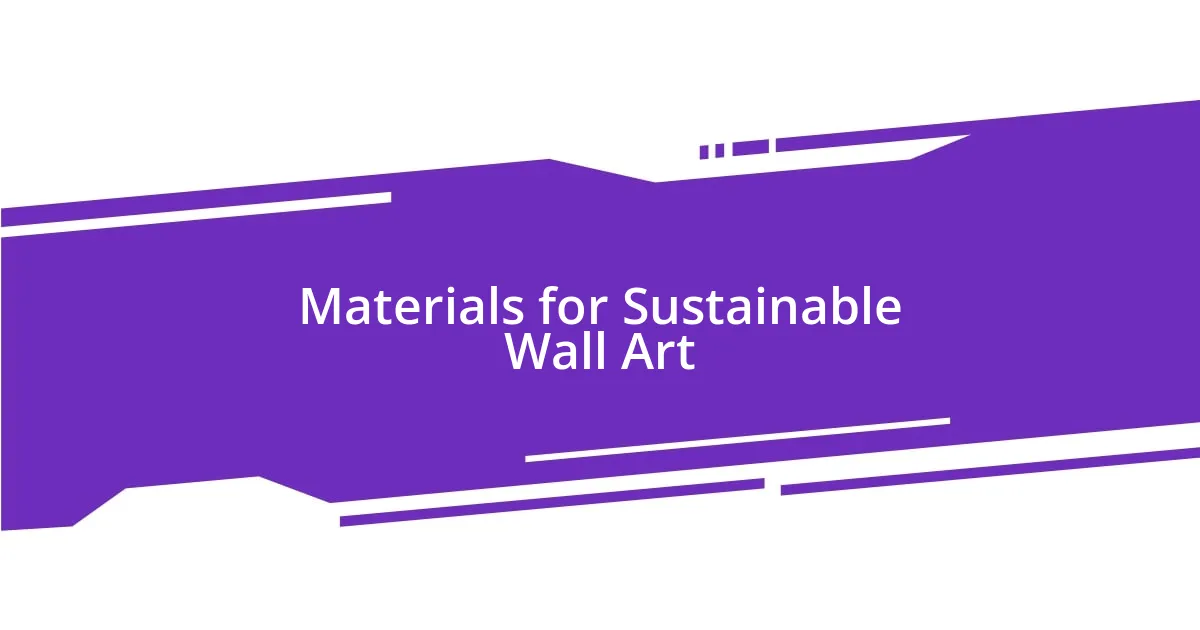Key takeaways:
- Sustainable wall art utilizes eco-friendly materials and practices, promoting environmental awareness and personal connection to nature.
- Choosing eco-friendly art supports sustainable practices, enhances well-being, and encourages meaningful conversations about consumption habits.
- DIY sustainable art projects allow individuals to creatively repurpose materials while aligning personal expression with eco-conscious values.
- Proper care for sustainable art, including mindful storage and maintenance, ensures longevity and preserves the story behind each piece.

Understanding Sustainable Wall Art
Sustainable wall art refers to artworks created using eco-friendly materials and practices that minimize environmental impact. I often find myself entranced by pieces that tell a story—not only through their visuals but also through the materials they’re made from. Isn’t it fascinating to think that a beautiful canvas could be crafted from recycled materials or that the vibrant colors could come from natural pigments?
When I first learned about sustainable art, I was surprised to discover how many artists are committed to creating pieces that align with their values. For instance, I visited a local gallery where the artist used reclaimed wood for both the frame and the canvas. I could almost feel the memories embedded in that wood, bringing a unique energy to the piece. Can art really carry the history of its materials? In my experience, it absolutely can.
It’s not just about the materials; it’s also about the message. Many artists incorporate themes that celebrate nature and promote conservation, giving us something to reflect on as we decorate our spaces. I think about how choosing sustainable wall art isn’t just a purchase but a lifestyle choice, strengthening our connection to the earth while filling our homes with beauty. What could be more fulfilling than surrounding ourselves with art that aligns with our desire to live sustainably?

Benefits of Eco-Friendly Art
Eco-friendly art offers numerous benefits that can enhance both your living space and your connection to the environment. I remember the thrill of discovering a stunning piece made entirely from recycled glass. Not only did it brighten up my room, but it also sparked conversations about sustainability among my friends. That moment made me realize how art can be a catalyst for change, encouraging us to think more deeply about our consumption habits.
Here are some key benefits of choosing eco-friendly art:
- Supports Sustainable Practices: By selecting art made from renewable or recycled materials, you’re directly supporting artists who prioritize eco-friendly methods.
- Promotes Awareness: Many eco-conscious artists weave environmental themes into their work, creating awareness around conservation and sustainability.
- Unique Materials: Eco-friendly art often utilizes unconventional materials, resulting in distinctive pieces that bring character to your space.
- Enhances Well-being: Surrounding ourselves with nature-inspired art can improve our mood and encourage a calming atmosphere.
- Long-lasting Impact: Eco-conscious art can inspire lasting behavioral changes, motivating viewers to adopt more sustainable practices in their own lives.

Materials for Sustainable Wall Art
Sustainable wall art can be created from a variety of materials, each bringing its own unique appeal and story. For instance, I find the use of bamboo particularly captivating. Not only is bamboo a rapidly renewable resource, but its natural aesthetic brings warmth and texture to any space. I’ve hung a bamboo-framed print in my living room, and it sparks joy every time I see it, reminding me of the forests it came from. But it’s not just bamboo; many artists today are utilizing reclaimed materials such as old fabrics and scrap metals, which don’t just add character but also layer a narrative of sustainability to the artwork.
When considering sustainable options, it’s essential to think about the pigments used as well. I’ve encountered pieces that use plant-based or mineral pigments, and the colors seem to resonate with nature itself. The depth of these colors often outshines traditional synthetic paints, bringing a vibrancy that feels alive. As I’ve learned, art can turn any wall into a conversation starter—especially when the story behind its creation is as rich as the piece itself. Choosing art that speaks to our environmental responsibility can genuinely transform how we see our home.
To further explore the various materials available for sustainable wall art, I’ve put together a comparison table. This highlights some common eco-friendly options and their benefits:
| Material | Benefits |
|---|---|
| Bamboo | Rapidly renewable, natural aesthetic |
| Reclaimed Wood | Unique history, reduces waste |
| Recycled Glass | Innovative, brightens spaces |
| Plant-Based Pigments | Vibrant colors, non-toxic |
| Old Fabrics | Soft texture, eco-friendly craftsmanship |

Finding Local Artisans and Artists
Finding local artisans and artists can be an exciting journey that leads to unique discoveries. I remember visiting a weekend art fair in my town and connecting with a painter who used only local materials. It was heartwarming to hear her talk about how each brushstroke was inspired by our shared environment. Isn’t it incredible how local art can tell the story of a community?
One fantastic way to uncover talented local artists is through social media platforms. I often browse local groups and hashtags to spot new creations in my area, and it’s astonishing how many hidden gems I’ve found this way. I once stumbled upon a sculptor who transformed discarded items from our local beach into breathtaking wall art. It’s like taking a treasure hunt to another level; every scroll through my feed brings a new opportunity for inspiration!
Additionally, local galleries and craft fairs are invaluable resources for meeting artisans who prioritize sustainability. I distinctly remember attending a pop-up gallery in a community center where I met a textile artist committed to using organic fabrics. Engaging in conversations with these creators not only deepens my appreciation for their work but also encourages me to support their locally sourced, sustainable practices. Have you explored these local venues? You might be surprised at the talent just waiting to be discovered in your neighborhood!

DIY Sustainable Wall Art Ideas
Creating DIY sustainable wall art is an exciting way to express yourself while being eco-conscious. One of my favorite projects was turning old wooden pallets into a rustic wall hanging. It was a labor of love, requiring some sanding and a splash of plant-based paint, but the satisfaction of repurposing those discarded materials was immense. Every time I glance at that piece, I’m reminded not just of my creativity but also of the story behind it—how something once considered waste is now a centerpiece of my decor.
I’ve also had a blast crafting wall art from pressed flowers gathered during nature walks. This simple process involves using a flower press or even heavy books to dry the blooms, which can then be framed in recycled glass. I remember the first time I hung one of these in my hallway; it felt like a slice of nature was brought indoors. Seeing the delicate colors and intricate shapes not only brightens up that space but also sparks conversations about the beauty of our local flora. Do you have a favorite flower that you could display this way?
Using upcycled paper for collage art has become another passion of mine. I enjoy collecting scrap paper, old maps, or even pages from books that were destined for recycling. When I sit down to create, I feel a sense of purpose, knowing that my art is not just beautiful but also diverts waste from landfills. I encourage you to try this technique; you might find that each layer tells a story, and the final product can reflect personalized themes that resonate with you or your loved ones. Isn’t it amazing how creativity can transform waste into something meaningful?

Creating a Sustainable Art Gallery
Creating a sustainable art gallery starts with selecting pieces that reflect eco-conscious values. A few years ago, I visited a gallery that exclusively showcased artwork made from recycled materials. It was so inspiring to see how artists transformed everyday waste into stunning visual narratives. Have you ever visited a space that felt like a celebration of sustainability? It truly opens your eyes to the creativity that can flourish when waste is reimagined.
When I think about the layout of a sustainable art gallery, lighting plays a crucial role. Natural light not only enhances the beauty of each piece, but it also reminds us to embrace energy-efficient practices. I recall helping a friend set up her gallery, where we strategically placed skylights to use sunlight as the primary illumination. The resulting atmosphere felt warm and inviting, and the artworks practically radiated a life of their own. Isn’t it fascinating how much of an impact our environment can have on an art piece?
Additionally, collaborating with local artists not only brings a sense of community but also emphasizes the importance of ethical sourcing. I once organized an event where artists crafted live installations from sustainable materials harvested right from our surroundings. I was amazed by how profoundly participants connected with the process, as they witnessed the transformation of raw materials into stunning art. Have you ever participated in an event like that? It became a beautiful reminder that art can be a catalyst for change, connecting us not just to each other, but to the environment as well.

Caring for Your Sustainable Art
Caring for sustainable art is much like nurturing a living creation; it requires attention and love. For example, I learned the hard way that sunlight can be both a friend and a foe. After hanging a vibrant upcycled canvas near a sunny window, I noticed the colors fading over time. Now, I always consider the lighting in my space, ensuring that my pieces have a balance between visibility and protection. How do you organize your artwork to keep it looking fresh?
Another essential aspect is choosing the right cleaning methods. I once attempted to dust off a delicate paper collage with a damp cloth, only to find that it caused the paper to warp. Since then, I’ve switched to a soft, dry brush, which gently removes dust without causing damage. Caring for these pieces is about mindful interaction, ensuring they last not just for us but also for future generations to enjoy. Have you found a cleaning method that works perfectly for your art?
Lastly, I’ve taken to storing extra artwork in eco-friendly portfolios made from recycled materials. This practice not only protects my art from wear and tear but also aligns with my values of sustainability. I remember when I had to shuffle pieces around during a move; having them safely stored made the process so much easier. How do you store your memories? Keeping sustainable art in good condition enhances its story, making each piece even more meaningful over time.












